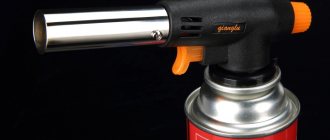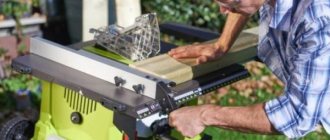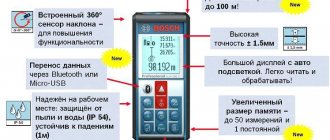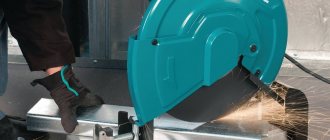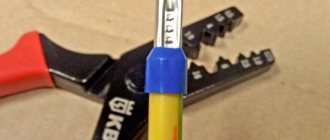Deep metal detectors are in demand by search teams, meteorite iron hunters, and archaeologists. They are designed to detect large objects at great depths. Discrimination is not their task, and if it is, it’s a nice bonus.
Read also: The law on metal detectors - how to avoid going to jail, losing your metal detector, or receiving a million-dollar fine?! Read the article.
Design and principle of operation of the device
Depth detectors are not built according to the VLF scheme, typical of conventional metal detectors. The main function is the screening of small metal debris, a kind of weight and size discrimination of targets. To achieve record search depths, large search detectors are used - not only coils, but also square frames measuring from one meter to one meter or more.
Metal detector based on the transmit-receive principle
The proposed metal detector is designed for “long-distance” search for relatively large objects. It is assembled according to the simplest scheme without a discriminator by type of metal. The device is easy to manufacture.
Detection depth is:
| gun | 0.5 (m) |
| helmet | 1m) |
| bucket | 1.5 (m) |
Rice. 17. Block diagram of a metal detector based on the “transmission-reception” principle.
The block diagram is shown in Fig. 17. It consists of several functional blocks. The generator is a source of rectangular pulses, from which a signal is subsequently generated that goes to the emitting coil. The same signal is used to generate a sound indication signal. The oscillator signal is divided by frequency by 4 using a ring counter on the flip-flops. According to the ring circuit, the counter is designed so that two signals can be generated at its outputs, shifted relative to each other in phase by 90°.
A rectangular signal (meander) is supplied from the first output of the ring counter to the input of a power amplifier, the load of which is an oscillating circuit with a radiating coil. By its type, the power amplifier is a voltage-to-current converter, which makes it possible to prevent overloads of the output stage when the polarity of the input rectangular signal of the power amplifier changes.
The receiving voltage amplifier amplifies the signal coming from the receiving coil. In addition to the useful signal, a parasitic signal also penetrates into the receiving coil, due to the imperfect design of the metal detector coil system, soil conductivity, and other reasons. A compensation scheme is designed to eliminate this. The meaning of its operation is that some part of the signal from the output oscillatory circuit is mixed into the signal of the receiving amplifier so as to minimize (ideally, bring to zero) the output signal of the synchronous detector in the absence of metal objects near the sensor. The compensation circuit is adjusted using an adjustment potentiometer.
A synchronous detector converts the useful AC signal coming from the output of the receiving amplifier into a DC signal. An important feature of a synchronous detector is the ability to isolate a useful signal from a background of noise and interference that significantly exceeds the useful signal in amplitude. The reference signal of the synchronous detector is taken from the second output of the ring counter, the signal of which has a phase shift relative to the first output by 90°. The dynamic range of changes in the useful signal both at the output of the receiving coil and at the output of the synchronous detector is very wide.
In order for an indication device - a pointer device or a sound indicator to record both very weak signals and very (for example, 100 times) stronger signals equally well, it is necessary to have a device in the device that compresses the dynamic range. Such a device is a nonlinear amplifier, the amplitude characteristic of which approaches logarithmic. A pointer measuring device is connected to the output of the nonlinear amplifier.
The formation of an indication sound signal begins with a limiter at the minimum, i.e. a block that has a dead zone for small signals. This means that the sound indication is turned on only for signals exceeding a certain threshold in amplitude. Thus, weak signals, mainly associated with the movement of the device and its mechanical deformations, do not irritate the ear.
The sound indication reference signal generator generates packets of rectangular pulses with a frequency of 2 (kHz) with a repetition frequency of the packets of 8 (Hz). Using a balanced modulator, this reference signal is multiplied by the output signal of the limiter at the minimum, thus forming a signal of the desired shape and amplitude. The piezo emitter amplifier increases the amplitude of the signal that goes to the acoustic transducer - the piezo emitter. Schematic diagram
The schematic diagram of the metal detector developed by the author according to the “transmission-reception” principle is shown in Fig. 18 - input block and Fig. 19 - indication block. The division into blocks is arbitrary and does not reflect the design features.
Fig. 18. Schematic diagram of the input block of a metal detector based on the “transmission-reception” principle.
Generator
Assembled on logical elements 2I-NOT D1.1-D1.4. The generator frequency is stabilized by a quartz or piezoceramic resonator Q with a resonant frequency of 2^15(Hz)" 32(kHz) (“clock quartz”). The R1C1 chain prevents the generator from being excited at higher harmonics. The OOS circuit is closed through resistor R2, and the POS circuit is closed through resonator Q. The generator is simple, has low current consumption from the power source, operates reliably at a supply voltage of 3^(-15)(V), and does not contain tuning elements or overly high-resistance resistors. The output frequency of the generator is about 32 (kHz).
Ring counter
The ring counter has two functions. Firstly, it divides the generator frequency by 4, up to a frequency of 8 (kHz) (recommendations for choosing a frequency - see Chapter 1.1). Secondly, it generates two signals, shifted relative to each other by 90° in phase. One signal is used to excite the oscillating circuit with the emitting coil, the other is used as a reference signal for the synchronous detector. The ring counter consists of two D-flip-flops D2.1 and D2.2, closed in a ring with signal inversion along the ring. The clock signal is common to both triggers. Any output signal of the first trigger D2.1 has a phase shift of plus or minus a quarter of a period (i.e. 90°) relative to any output signal of the second trigger D2.2.
Amplifier
Assembled on an operational amplifier (op-amp) D3.1. The oscillating circuit with the emitting coil is formed by elements L1C2. The parameters of the inductor are shown in the table. The brand of winding wire is PELSHO 0.44.
The output oscillatory circuit is only 25% included in the amplifier's feedback circuit, thanks to the tap from the 50th turn of the radiating coil L1. This allows you to increase the amplitude of the current in the coil at an acceptable value of the capacitance of the precision capacitor C2.
Table. Parameters of the sensor inductors.
| Designation | Purpose | Number of turns | Int. diameter |
| L1 | radiating | 50+150 | 190mm |
| L2 | reception | 100 | 125mm |
The amount of alternating current in the coil is set by resistor R3. This resistor must have a minimum value, but such that the op-amp of the power amplifier does not fall into the mode of limiting the output signal by current (no more than 40 (mA)) or, which is most likely given the recommended parameters of the inductor L1, by voltage (no more ±3.5(V) at battery voltage ±4.5(V)). In order to make sure that there is no limiting mode, it is enough to check the signal shape at the output of op-amp D3.1 with an oscilloscope. During normal operation of the amplifier, there should be a signal at the output that is close in shape to a sine wave. The tops of the sinusoid waves should have a smooth shape, and there should be no “cutting” of the tops. The correction circuit of op-amp D3.1 consists of a correction capacitor SZ with a capacity of 33 (pF).
Receiving amplifier
The receiving amplifier is two-stage. The first stage is made using op-amp D5.1. It has a high input impedance due to its serial voltage feedback. This makes it possible to eliminate losses of the useful signal due to shunting of the oscillating circuit L2C5 by the input impedance of the amplifier. The voltage gain of the first stage is: Ku = (R9/R8) + 1 = 34. The op-amp correction circuit D5.1 consists of a correction capacitor C6 with a capacity of 33 (pF).
The second stage of the receiving amplifier is made using op-amp D5.2 with parallel voltage feedback. The input resistance of the second stage: Rin = R10 = 10(k0m) is not as critical as the first, due to the low resistance of its signal source. Separating capacitor C7 not only prevents the accumulation of static errors in the amplifier stages, but also corrects its phase response. The capacitance of the capacitor is selected such that the phase advance created by the C7R10 chain at an operating frequency of 8 (kHz) compensates for the phase lag caused by the finite speed of op-amps D5.1 and D5.2.
The second stage of the receiving amplifier, thanks to its circuitry, makes it easy to sum (mix) the signal from the compensation circuit through resistor R11. The gain of the second stage for the useful signal voltage is: Ku = - R12/R10 = -33, and for the compensating signal voltage: Ku = -R12/R11" -4. The correction circuit of the op amp D5.2 consists of a correction capacitor C8 with a capacity of 33 (pF).
Compensation scheme
Built on op-amp D3.2 and is an inverter with Ku = - R7/R5 = -1. The adjusting potentiometer R6 is connected between the input and output of this inverter and allows you to remove a signal lying in the range [-1, +1] from the output voltage of op-amp D3.1. The output signal of the compensation circuit from the adjustment potentiometer R6 is supplied to the compensating input of the second stage of the receiving amplifier (to resistor R11). By adjusting potentiometer R6, a zero value is achieved at the output of the synchronous detector, which approximately corresponds to compensation for the unwanted signal that has penetrated the receiving coil. The correction circuit of op-amp D3.2 consists of a correction capacitor C4 with a capacity of 33 (pF).
Synchronous detector
A synchronous detector consists of a balanced modulator, an integrating chain and a constant signal amplifier (CSA). The balanced modulator is implemented on the basis of a multifunctional switch D4, made using integrated technology with complementary field-effect transistors both as discrete control valves and as analog switches. The switch operates as an analog switch. With a frequency of 8 (kHz), it alternately closes the “triangle” outputs of the integrating chain, consisting of resistors R13 and R14 and capacitor C10, to the common bus. The reference frequency signal is supplied to the balanced modulator from one of the outputs of the ring counter.
The signal to the input of the “triangle” of the integrating chain comes through the isolation capacitor C9 from the output of the receiving amplifier. Time constant of the integrating chain t» R13·C10 = R14·C10. On the one hand, it should be as large as possible in order to reduce the influence of noise and interference as much as possible. On the other hand, it should not exceed a certain limit when the inertia of the integrating chain prevents tracking rapid changes in the amplitude of the useful signal.
The highest rate of change in the amplitude of the useful signal can be characterized by a certain minimum time during which this change can occur (from a steady value to the maximum deviation) when the metal detector sensor moves relative to a metal object. Obviously, the maximum rate of change in the amplitude of the useful signal will be observed at the maximum speed of the sensor. It can reach 5 (m/s) for the “pendulum” movement of the sensor on the rod. The time of change in the amplitude of the useful signal can be estimated as the ratio of the sensor base to the speed of movement. Setting the minimum value of the sensor base equal to 0.2(m), we obtain a minimum time of change in the amplitude of the useful signal of 40(ms). This is several times greater than the time constant of the integrating chain for the selected values of resistors R13, R14 and capacitor C10. Consequently, the inertia of the integrating chain will not distort the dynamics of even the fastest of all possible changes in the amplitude of the useful signal from the metal detector sensor.
The output signal of the integrating chain is removed from capacitor C 10. Since both plates of the latter are under “floating potentials,” the UPS is a differential amplifier made using op-amp D6. In addition to amplifying the constant signal, the UPS performs the function of a low-pass filter (LPF), which further attenuates unwanted high-frequency components at the output of the synchronous detector, mainly associated with the imperfection of the balanced modulator. The low-pass filter is implemented thanks to capacitors C 11, C 13. Unlike other components of the metal detector, the UPS op-amp should be close in its parameters to precision op-amps. First of all, this relates to the magnitude of the input current, the magnitude of the bias voltage, and the magnitude of the temperature drift of the bias voltage. A good option that combines good parameters and relative affordability is an op-amp type K140UD14 (or KR140UD1408). The correction circuit of op-amp D6 consists of a correction capacitor C12 with a capacity of 33 (pF).
Nonlinear amplifier
Made on op-amp D7.1 with nonlinear feedback in voltage. Nonlinear OOS is implemented by a two-terminal network consisting of diodes VD1-VD8 and resistors R20-R24. The amplitude response of a nonlinear amplifier approaches logarithmic. It is a piecewise linear approximation of the logarithmic dependence, with 4 break points for each polarity. Due to the smooth shape of the current-voltage characteristics of the diodes, the amplitude characteristic of the nonlinear amplifier is smoothed out at the break points.
Fig. 19. Schematic diagram of the metal detector display unit based on the “transmission-reception” principle.
The small-signal voltage gain of a nonlinear amplifier is: Kuk = -(R23+R24)/R19 » -100. As the amplitude of the input signal increases, the gain decreases. The differential gain for a large signal is: dUout/dUin = - R24/R19 = -1. A pointer measuring device is connected to the output of the nonlinear amplifier - a microammeter with an additional resistor R25 connected in series. Since the voltage at the output of a synchronous detector can have any polarity (depending on the phase shift between its reference and input signals), a microammeter with zero in the middle of the scale is used. Thus, the pointer device has an indication range of -100 ... 0 ... +100 (μA). The op-amp correction circuit D7.1 consists of a correction capacitor C 18 with a capacity of 33 (pF).
Minimum limiter
Implemented on op-amp D7.2 with nonlinear parallel voltage feedback. The nonlinearity is contained in the input two-terminal network and consists of two back-to-back diodes VD9, VD10 and resistor R26.
The formation of an indication audio signal from the output signal of a nonlinear amplifier begins with another adjustment of the amplitude characteristics of the amplification path. In this case, a dead zone is formed in the region of small signals. This means that the audio indication is only activated for signals exceeding a certain threshold. This threshold is determined by the forward voltage of the diodes VD9, VD10 and is about 0.5 (V). Thus, weak signals, mainly associated with the movement of the device and its mechanical deformations, are cut off and do not irritate the ear.
The limiter's small-signal gain is zero at its minimum. The differential voltage gain for a large signal is: dUout/dUin = - R27/R26 = -1. The op amp correction circuit D7.2 consists of a correction capacitor C 19 with a capacity of 33 (pF).
Balanced modulator
The sound indication signal is generated as follows. A constant or slowly changing signal at the output of the limiter is multiplied to a minimum by the reference signal of the audio indication. The reference signal sets the shape for the audio signal, and the minimum limiter output signal sets the amplitude. Multiplication of two signals is carried out using a balanced modulator. It is implemented on a multifunctional switch D11, operating as an analog switch, and op-amp D8.1. The transmission coefficient of the device is +1 when the key is open and -1 when it is closed. The op amp correction circuit D8.1 consists of a correction capacitor C20 with a capacity of 33 (pF).
Sound indication reference signal generator
Implemented on a binary counter D9 and a counter decoder D10. Counter D9 divides the 8(kHz) frequency from the ring counter output to 2(kHz) and 32(Hz). A signal with a frequency of 2 (kHz) is supplied to the low-order bit of address A0 of the multifunctional switch D11, thus setting a tone signal with the most sensitive frequency for the human ear. This signal will affect the analog switch of the balanced modulator only if the most significant bit of the address A1 of the multifunctional switch D11 is present with a logical one. When A1 is logic zero, the analog switch of the balanced modulator is always open.
The sound indication signal is generated intermittently to reduce hearing fatigue. For this, a counter-decoder D10 is used, which is controlled by a clock frequency of 32 (Hz) from the output of the binary counter D9 and generates at its output a rectangular signal with a frequency of 8 (Hz) and a ratio of the duration of a logical unit to a logical zero equal to 1/3. The output signal of the counter decoder D10 is sent to the most significant bit of address A1 of the multifunctional switch D11, periodically interrupting the formation of a tone message in the balanced modulator.
Piezo amplifier
Implemented on op-amp D8.2. It is an inverter with voltage gain Ku = -1. The amplifier load - a piezo emitter - is connected via a bridge circuit between the op-amp outputs D8.1 and D8.2. This allows you to double the amplitude of the output voltage at the load. Switch S is designed to turn off the sound indication (for example, during setup). The op amp correction circuit D8.2 consists of a correction capacitor C21 with a capacity of 33 (pF). Types of parts and design
The types of microcircuits used are shown in the table. Instead of K561 series microcircuits, it is possible to use K 1561 series microcircuits. You can try to use some K 176 series microcircuits and foreign analogues.
Dual operational amplifiers (op-amps) of the K 15 7 series can be replaced by any single general-purpose op-amps with similar parameters (with appropriate changes in pinout and correction circuits), although the use of dual op-amps is more convenient (the installation density increases). The op amp of the synchronous detector D6, as already mentioned above, in its parameters should be close to precision op amps. In addition to the type indicated in the table, K140UD14, 140UD14 are suitable. It is possible to use OU K140UD12, 140UD12, KR140UD1208 in the corresponding switching circuit.
Table. Microcircuits used.
| Designation according to Fig. 18, Fig. 19 | Type | Functional purpose |
| D1 | K561LA7 | 4 elements 2I-NOT |
| D2 | K561TM2 | 2 D-triggers |
| D3, D5, D7, D8 | K157UD2 | dual op-amp |
| D4,D11 | K561KP1 | 2 4 to 1 switches |
| D6 | KR140UD1408 | precise op-amp |
| D9 | K561IE10 | 2 binary counter |
| D10 | K561IE9 | decoder counter |
There are no special requirements for the resistors used in the metal detector circuit. They just need to have a solid design and be easy to install. Nominal power dissipation 0.125 - 0.25 (W).
Compensation potentiometer R6 is preferably multi-turn type SP5-44 or with vernier adjustment type SP5-35. You can get by with conventional potentiometers of any type. In this case, it is advisable to use two of them. One - for rough adjustment, with a nominal value of 10 (k0m), switched on in accordance with the diagram. The other is for fine adjustment, connected according to a rheostat circuit into the gap of one of the outer terminals of the first potentiometer, with a nominal value of 0.5-1(k0m).
Capacitors C 15, C 17 are electrolytic. Recommended types - K50-29, K50-35, K53-1, K53-4 and other small-sized ones. The remaining capacitors, with the exception of the capacitors of the oscillating circuits of the receiving and emitting coils, are ceramic type K 10-7 (up to nominal 68 (nF)) and metal film type K73-17 (nominal above 68 (nF)). The circuit capacitors - C2 and C5 - are special. They are subject to high demands on accuracy and thermal stability. Each capacitor consists of several (5...10 pcs.) capacitors connected in parallel. Tuning the circuits to resonance is carried out by selecting the number of capacitors and their rating. Recommended type of capacitors K 10-43. Their thermal stability group is MPO (i.e. approximately zero TKE). It is possible to use precision capacitors of other types, for example, K71-7. In the end, you can try to use old-fashioned thermally stable mica capacitors with silver plates like KSO or polystyrene capacitors.
Diodes VD1-VD10 type KD521, KD522 or similar low-power silicon.
Microammeter - any type for a current of 100 (μA) with zero in the middle of the scale. Small-sized microammeters, for example, type M4247, are convenient.
Quartz resonator Q - any small-sized watch quartz (similar ones are also used in portable electronic games).
Power switch - any type, small-sized. The batteries are 3R12 type according to the international designation, “square” according to ours.
Piezo emitter Y1 - can be of type 3P1...3P18. Good results are obtained when using piezo emitters from imported phones (they are used in huge quantities when making phones with caller ID).
The design of the device can be quite arbitrary. When developing it, it is advisable to take into account the recommendations outlined below, as well as in the paragraphs devoted to sensors and housing design.
The appearance of the device is shown in Fig. 20.
Fig.20. The design of the metal detector is based on the “transmission-reception” principle. General form.
By its type, the sensor of the proposed metal detector belongs to sensors with perpendicular axes. The sensor coils are glued together from fiberglass with epoxy glue. The windings of the coils along with the fittings of their electrical screens are filled with the same glue. The metal detector rod is made of an aluminum alloy pipe (AMGZM, AMG6M or D16T) with a diameter of 48 mm and a wall thickness of 2-3 mm. The coils are glued to the rod with epoxy glue. Coaxial (radiating) - using a transitional reinforcing sleeve, perpendicular to the axis of the rod (receiving) - using a suitable adapter shape. These auxiliary parts are also made of fiberglass. The housing of the electronic unit is made of foil fiberglass by soldering. The connections between the sensor coils and the electronic unit are made with shielded wire with external insulation and laid inside the rod. The screens of this wire are connected only to the common wire bus on the board of the electronic part of the device, where the housing screen in the form of foil and a rod are also connected. The outside of the device is painted with nitro enamel
The printed circuit board of the electronic part of the metal detector can be manufactured using any of the traditional methods; it is also convenient to use ready-made prototype printed circuit boards for DIP chip housings (pitch 2.5 mm). Setting up the device
It is recommended to set up the device in the following sequence.
1. Check the correct installation according to the schematic diagram. Make sure there are no short circuits between adjacent conductors of the printed circuit board, adjacent legs of microcircuits, etc.
2. Connect batteries or a bipolar power source, strictly observing the polarity. Turn on the device and measure the current consumption. It should be about 20(mA) on each power rail. A sharp deviation of the measured values from the specified value indicates incorrect installation or malfunction of the microcircuits.
3. Make sure that there is a pure square wave with a frequency of about 32 (kHz) at the output of the generator.
4. Make sure that there is a square wave with a frequency of about 8 (kHz) at the outputs of the D2 triggers.
5. By selecting capacitor C2, adjust the output circuit L1C2 to resonance. In the simplest case - by the maximum amplitude of the voltage across it (about 10 (V)), and more precisely - by the zero phase shift of the circuit voltage relative to the meander at output 12 of trigger D2.
6. Make sure the receiving amplifier is working. Set its input oscillatory circuit L2C5 to resonance. The parasitic signal penetrating from the emitting coil is quite sufficient as an input signal. Tuning into resonance, as for the output circuit, is carried out by soldering or removing the required number of capacitors of suitable ratings.
7. Make sure that the parasitic signal can be compensated by potentiometer R6. To do this, first use an oscilloscope to monitor the output of op-amp D5.2. When rotating the axis of potentiometer R6, the amplitude of the signal with a frequency of 8 (kHz) at the output of op-amp D5.2 should change and in one of the middle positions of the R6 slider this amplitude will be minimal. Next, you should check the output of the synchronous detector - the output of op-amp D6. When rotating the axis of potentiometer R6, the value of the constant signal at the output of op-amp D6 should change from a maximum value of +3.5 (V) to a minimum of -3.5 (V) or vice versa. This transition is quite sharp and in order to “catch” it, it is convenient to use the fine-tuning capabilities mentioned above. The setting consists of setting the voltage at the output of op-amp D6 to zero using potentiometer R6. Attention! Adjustment with potentiometer R6 must be carried out in the absence of large metal objects, including measuring instruments, near the metal detector sensor coils! Otherwise, when moving these objects or when moving the sensor relative to them, the device will be upset, and if there are large metal objects near the sensor, it will not be possible to set the output voltage of the synchronous detector to zero. For compensation, see also the paragraph on possible modifications below.
8. Make sure the nonlinear amplifier is working. The simplest way is visually. The microammeter must respond to the adjustment process made by potentiometer R6. At a certain position of the R6 engine, the microammeter needle should go to zero. The farther the microammeter needle is from zero, the weaker the microammeter should respond to the rotation of the R6 engine.
Attention !!!
It may turn out that an unfavorable electromagnetic environment will make it difficult to set up the device. In this case, the microammeter needle will perform chaotic or periodic oscillations as the potentiometer R6 moves closer to the position in which signal compensation should take place. The described undesirable phenomenon is explained by interference from higher harmonics of the 50 (Hz) network to the receiving coil. At a considerable distance from electrical wires, the needle should not oscillate during adjustment.
9. Make sure that the components that generate the sound signal are operational. Pay attention to the presence of a small dead zone for the audio signal near zero on the microammeter scale.
If there are malfunctions and deviations in the behavior of individual components of the metal detector circuit, you should follow the generally accepted method:
— check the absence of self-excitation of the op-amp,
— check the op-amp modes for direct current,
— signals and logical levels of inputs/outputs of digital microcircuits, etc. and so on.
Possible modifications
The design of the device is quite simple and therefore we can only talk about further improvements. These include:
1. Adding an additional compensation potentiometer R6*, connected in parallel with R6 at the outer terminals. The motor of this potentiometer is connected through a capacitor with a capacity of 510 (pF) (needs to be verified experimentally) to the inverting input 5 of op-amp D5.2. In this configuration, there will be two degrees of freedom when compensating for the parasitic signal (sine and cosine), which can help configure the device when operating with significant temperature differences in the sensor, with high soil mineralization, etc.
2. Adding an additional visual indication channel containing a synchronous detector, a nonlinear amplifier and a microammeter. The reference signal of the synchronous detector of the additional channel is taken with a shift of a quarter period relative to the reference signal of the main channel (from any output of another ring counter trigger). Having some search experience, you can learn to evaluate the nature of the detected object based on the readings of two pointer instruments, i.e. work no worse than an electronic discriminator.
3. Adding protective diodes connected in reverse polarity in parallel with the power supplies. If there is an error in the polarity of the batteries, this ensures that the metal detector circuit will not be damaged (although, if you do not react in time, the incorrectly connected battery will be completely discharged). It is not recommended to connect diodes in series with the power buses, since in this case 0.3-0.6 (V) of the precious voltage of the power supplies will be wasted on them. Type of protective diodes - KD243, KD247, KD226, etc.
Types of metal detectors
Deep metal detectors are built according to two schemes. The first of them is RF or Radio Frequency. For example, the Fisher Gemini 3. The RF principle is based on the use of two coils. The transmitting one is parallel to the ground, the receiving one is perpendicular.
Read also: Chinese metal detectors - review of expensive and cheap devices, comparison with American ones, customer reviews and choice of the best model
This determines the design of the device - it resembles a giant dumbbell that a treasure hunter carries in the middle.
The device operates at a frequency of 82 kHz.
Disadvantages of the scheme: large dimensions, shallow detection - it is impossible to make a large search detector, otherwise you will have to carry the metal detector on a non-metallic cart. And there is no discrimination against ferrous metal.
The metal detector according to the PI - Pulse Induction scheme does not have these disadvantages. There is only one coil, it is also receiving and it is transmitting. For example, the Bulgarian metal detector Deep Hunter 3 Pro SE can be supplied with a frame of 180x180 cm. And this frame can be carried by one person, although usually two people work - the instructions for the device prohibit being inside the frame.
Deep Hunter operates at a frequency from 100 to 400 kHz, can automatically tune out the ground, detects a helmet at a depth of up to 5 meters, and distinguishes between ferrous and non-ferrous metals.
Read also: Sphinx - review of the line of metal detectors, pros and cons and user reviews
Metal detector with metal discrimination
Modern metal detectors are equipped with a function such as metal discrimination. It allows you to distinguish the type of material located at depth. In this case, when ferrous metal is detected, one sound will sound in the search engine’s headphones, and when non-ferrous metal is detected, another sound will sound.
Such devices are classified as pulse-balanced. They use frequencies from 8 to 15 kHz in their work. Batteries of 9 - 12 V are used as a source.
Devices of this class are capable of detecting a gold object at a depth of several tens of centimeters, and ferrous metal products at a depth of about 1 meter or more.
Metal detector with metal discrimination
But, of course, these parameters depend on the device model.
Main settings
We have already found out that deep pits are built according to two different schemes. And for each scheme its own design parameters are important. For RF - the distance between the coils and their size. And for PI - frame size and power.
By selecting optimal design parameters, designers ensure that metal detectors achieve certain characteristics. About them below.
Detection depth
Fisher Gemini claims a detection depth of up to 9 meters, but it is not clear what exactly he detects at this depth - probably tanks of the Roman Empire.
It’s realistic to work with deep explorers to look for cannonballs at a depth of half a meter, meteorites, and discover dugouts by looking at the stoves in them. Up to three to five meters.
Read also: Mini metal detectors - how they work, why they were created and do you even need them?! The answers are in this article.
Operating frequency
For PI, frequencies are in the region of only 100-500 hertz, so when working near power lines, it would be nice to have detuning from electromagnetic interference - currents in power lines have frequencies of the same order - 50 or 60 Hz.
For RF such problems are not relevant.
What is a depth frame
The frames are operated by devices built according to the PI scheme. The frame is a square coil of one circuit. The side of the frame can be very large, but in reality the maximum size is 2 meters. Above that, it is already difficult to ensure the rigidity of the structure, and the weight is already too great - you cannot do without a cart built without a single nail.
Read also: TOP 5 most expensive metal detectors in the world today. A brief overview of these models.
What is the difference between depth probes with a frame and with a coil?
Using a depth detector with a coil is possible for regular searching, but VLF metal detectors are more effective when searching for coins. The depth worker begins to earn his price only with a frame. It’s not for nothing that most PI depth probes are sold as a set of frame and control unit. Rods and reels are additional accessories.
How do deep metal detectors differ from others?
Deep metal detectors can resemble conventional ones. But these are special cases. The depth coin, unlike a regular coin coin, looks either like a frame or like a large dumbbell, which the operator carries by the handle.
The same applies equally to depth nozzles - there are such for the Garrett 2500, for the XP Deus.
Read also: Teknetics Liberator - customer reviews, videos with findings and dismantling the device to the bones.
Functional and technical indicators
Before choosing and purchasing a good device, it is important to find out under what conditions the search will take place. In addition, it is important to take into account the dimensions of objects and the degree of occurrence. Key parameters:
- principle of influence;
- device frequency;
- susceptibility;
- weight;
- soil balancing;
- specifying the purpose;
- discriminator;
- auxiliary functionality.
The principle of influence and the operating range of the device are the main indicators that determine the capabilities of the detector. Susceptibility will determine the degree of occurrence of objects. The discriminator helps to configure the product to search for a specific type of metal. This will allow the operator to concentrate on the desired item.
Metal detector with discriminator
What is important to know when buying a deep metal detector
It is important to be aware that the manufacturer measured the detection depth under ideal conditions - in clean ground, with an intact target. In real life, you have to work in littered areas, and helmets, cannonballs and other targets are pretty much damaged by corrosion.
When choosing, you should pay attention to the possibility of using both coils and frames, stability of operation, good ignoring of small debris, the possibility of detuning from the ground and radio interference from power lines, telephones, and other electronics.
A detection depth of 3-4 meters for a large target (a metal helmet) is sufficient for most tasks; there is no need to chase depth at the expense of stability or filtering debris. Popular wisdom says: “a bad head gives no rest to your feet.” And in our case, the wrong choice of a metal detector is fraught with fruitless excavations to great depths.
Read also: Teknetics G2 - why is this device so loved abroad and they don’t know anything about it in the CIS?!
How to Use AKS to Detect Gold
Place the device parallel to the soil and turn it on by pressing the button for selecting the desired target for search (for example, gold). Then start searching according to the size of the area - in this case, the device sends signals in the vertical and horizontal planes, and then you will need to go around this area in search of the exact vector to the target. Here's a clearer picture:
Diagram of a deep metal detector
We looked at two deep depth schemes: RF and PI. Undoubtedly, the PI scheme is much simpler to implement, and it has more advantages compared to RF - one antenna (coil or frame) is needed, not two, the design is more convenient to use and the detection depth is greater.
You don’t have to buy such a metal detector; you can make it yourself. At the same time, the costs will be completely ridiculous compared to industrial devices. More on this below.
Read also: Teknetics Alpha 2000 - a detailed review of the device and comparison with competitors in the same price category
How does a metal detector and its structure work?
The operating principle of the device is based on the laws of physics, which make it possible to recognize objects at a distance. The action is directed and limited. The more expensive the metal detector, the greater the radius of its operation and the sensitivity of the detector. Complex models have a metal recognition function. Each type of metal interacts in its own way with the frequency of the search circuit, and the device compares the reaction with the standard and displays information for the operator on the display or sounds a sound signal.
In another popular design, the device analyzes the phase shift in the transmitting and receiving coils. When there are no metals in the detector's coverage area, the coil transmits a signal with a small amplitude. As you approach the search object, the amplitude increases. Thus, you can distinguish between non-ferrous and ferrous metals and detect voids in the ground. The structure of the metal detector is shown in the following diagram.
Diagram of a metal detector with different operating principles
Homemade metal detector: diagram and detailed description of the assembly
Our hands are not for boredom. To make a deep metal detector with your own hands, you need to arm yourself with a circuit diagram, elemental base and use a sober head and straight arms. In addition to radio components, you will need a frame for the frame and a suitable box for the control unit housing.
Parts for assembling a metal detector
On the Internet you can buy a kit for making your own metal detector. A printed circuit board and a handful of radio components will cost 500 rubles. https://md-kit.ru/nabor-dlya-sborki-pirat-k157ud2_Z6
This set is more than enough to get you started. If you are interested in manufacturing, you can go further, search for or independently calculate circuits, etch printed circuit boards and assemble more and more advanced metal detectors.
Read also: Teknetics T2 - detailed analysis of abilities and reviews from real users
DIY metal detector circuits
On the page https://zakonoma.net/metalloiskatel-svoimi-rukami/glubinnyj-metalloiskatel-svoimi-rukami.html you can find a circuit diagram for independently wiring the control unit of a deep metal detector.
Let's get acquainted, there is also a list of necessary radio components, tools and auxiliary materials. We buy and get started.
How to assemble a metal detector without using microcircuits
The circuit from the previous chapter assumes the use of integrated circuits. If the treasure hunter decides to do without them altogether, no problem, follow the link https://zakonoma.net/metalloiskatel-svoimi-rukami/18-metalloiskatel-pirat.html. The Pirate metal detector, which is presented there, can only be made using transistors, diodes, capacitors and resistors.
Read also: Teknetics Eurotek - videos from the field, real customer findings and analysis of settings
How to assemble a metal detector circuit board with your own hands
Radio amateurs know that there is more than one option for assembling a circuit. You can use factory patch panels, you can connect radio components with conductors. Or you can follow the classic path - we take a sheet of foil getinax or textolite, cut it to the required size, trace it, varnish the routes and etch it with a solution of hydrogen peroxide, electrolyte and table salt. Then comes the soldering iron stage - we tin the board.
How to make a metal detector coil with your own hands
Depth explorers using PI technology work with both coils and frames. Both the one and the other are a copper cable circuit that works for both reception and transmission.
Watch a video about making a frame yourself from old fishing rods and 0.9 mm copper conductor. It was published by the channel In Search of Metal.
Read also: How to avoid going to jail straight from the fields or losing your metal detector? Read the article and get the answers.
Copper wire spool on wooden base
The depth explorer does not live by limits alone. Comrade Vitaly Bogachev is a real master, he makes a decent reel from plywood. It winds with an ordinary insulated copper cable, selecting the number of turns experimentally.
Twisted pair coil in 5 minutes
To avoid breakage or breakage of the only conductor in the coil, you can make it from multi-core wire, for example, the same UTP - unshielded twisted pair.
The Seekers' World website provides detailed instructions. All you need is three meters of twisted pair cable, a piece of two-core cable for one and a half meters, a soldering iron and electrical tape.
Making a coil for a pulse metal detector with your own hands
Instructions for creating a Terminator 3 detector yourself
The device in question is widespread among many users. Over the long period of its existence, the product has been improved many times. You can use a step-by-step guide on how to make your own detector at home. The device is characterized by low energy consumption. It is possible to configure the device to search for specific types of metal. In addition, the device has good depth indicators.
Tools
Before assembling a homemade detector, you will need the following tools:
- soldering device;
- solder and rosin;
- pliers;
- screwdrivers;
- hacksaw;
- auxiliary devices for measurements.
Toolkit for radio amateur
Schematic, selection of parts and board
To create a control unit, you will need to make a wiring diagram where the main components are located. The board is transferred to a foil-coated getinax plate. The scheme is made similarly to the “Pirate” model. The dimensions of the board vary between 10.5 by 6.5 cm.
Coil
This is the most sensitive part of the metal detector, which provides scanning of the underground perimeter. The main stages of creating a standard detector coil:
- On a plywood sheet, 2 circles are drawn, similar in diameter to the coils. Nails are hammered over the entire area. The outside diameter of the winding varies within 20 cm. The coil is mounted from 2 connected wires. Next, the wire is wound around the nails (25 turns).
- Now the winding needs to be tied using threads. Then the nails are removed, and the manufactured coil is opened with varnish. After drying, it is wrapped with insulation. Likewise, the user must make a winding inside. It is 2 times smaller and contains 50 turns of wire.
- The coils are mounted inside the housing. Then the wires connected to the control unit are unsoldered.
DIY detector coil
Brief instructions for setting up a DIY metal detector
It’s not enough just to assemble a metal detector. It also needs to be configured so that it ignores small metal objects - otherwise it’s all in vain.
The DIY website gives comprehensive instructions on how to set up a homemade metal detector. Three variable resistors used in the circuit make it possible to do this with maximum convenience. Let's read. https://www.sdelai-sam.su/index3.html
Read also: How not to go to prison for 5 years straight from the fields and not lose your metal detector if the police notice you on a cop with a device.
Video
To be honest, it was not possible to find information in Russian anywhere, so everything you read above was collected from English-language sources, and translation is extremely difficult due to the inconsistency of the data. But since these AKS metal detectors are sold by a dozen sellers, it seems to be a popular thing. It’s still difficult to say how true this description is to reality, so if you have something to report on this device, go to the forum.
Discuss the article AKS DETECTOR-METAL DETECTOR OF GOLD AND DIAMOND
A device that allows you to search for metal objects located in a neutral environment, such as soil, due to their conductivity is called a metal detector (metal detector). This device allows you to find metal objects in various environments, including in the human body.
Largely thanks to the development of microelectronics, metal detectors, which are produced by many enterprises around the world, are highly reliable and have small overall and weight characteristics.
Sapper working with a metal detector
Not so long ago, such devices could most often be seen among sappers, but now they are used by rescuers, treasure hunters, and utility workers when searching for pipes, cables, etc. Moreover, many “treasure hunters” use metal detectors, which they assemble with their own hands .
Possible problems during assembly
The same Do It Yourself website warns of possible difficulties that may befall a homemade treasure hunter when assembling and setting up a metal detector. They mainly relate to incorrect geometry or winding of the coil, the use of defective or unusable used radio components.
Simple metal detectors from ready-made electrical appliances
- A metal detector can be made from a radio receiver by adding a simple HF transmitter to it:
The search coil is wound from 0.5 mm² wire: 16 turns 12 cm. When a metal object enters the range of action, a receiver tuned to the MW/LW range will change the tone of the sound. - A homemade metal detector made from a cell phone is nothing more than a myth. Upgrading its electrical circuit at home is not feasible, and it is technically impossible to make a standard mobile phone work as a metal detector.
- In fact, there is no need to make a metal detector out of a magnet. You simply bring a powerful neodymium magnet to the place where there is a metal object and physically feel the force of attraction. Of course, this only works with metals that have ferromagnetic properties (iron, steel).
Metal detector made from a radio and calculator
As promised at the beginning of the article, we will tell you how to make a metal detector using a radio and a calculator. Let us immediately note that such a device is definitely not suitable for searching for metals even under a thin layer of earth. But you can try to use it as a detector of hidden wiring in walls. For such a device you will need:
- Empty CD box.
- A radio receiver capable of operating in the AM range.
- Calculator.
- Double-sided tape.
To make a metal detector, you need to do the following operations:
- stick double-sided tape on the inside of the CD box flaps;
- attach a radio receiver to one leaf;
- A calculator is attached to the second flap.
That's it, the metal detector is ready. All that remains is to configure it. To do this, both devices need to be turned on and the radio set to operate at the maximum frequency. Then, by changing the mutual inclination of the calculator and the receiver, it is necessary to ensure that only a slight noise background from the electromagnetic waves emitted by the calculator is heard from the radio speaker. This position needs to be fixed, and you can begin testing the device by bringing it to metal objects and recording the change in sound.
Which coil resonance to choose?
When connecting the coil into series resonance, the current in the coil and the overall consumption of the circuit increases. The target detection distance increases, but this is only on the table. On real ground, the ground will be felt the more strongly, the greater the pump current in the coil. It is better to turn on parallel resonance, and increase the sense of input stages. And the batteries will last much longer. Despite the fact that sequential resonance is used in all branded expensive metal detectors, in Sturm it is parallel that is needed. In imported, expensive devices, there is a good detuning circuitry from the ground, so in these devices it is possible to allow sequential.
Homemade metal detector - pros and cons
Cheapness, the basic advantage of making any products yourself, is relevant for a metal detector. Here are some other advantages of a homemade device:
- best match to search technology for beginners;
- the ability to create a device with a completely individual shape, design and configuration;
- the pleasure of making an effective, efficient device yourself.
Like any device made by an amateur, a metal detector is not without some drawbacks.
Here are the features of the “Pirate” model that users note:
- high battery consumption;
- lack of discrimination, that is, precise sensitivity to ferrous, non-ferrous and precious metals;
- limited sensitivity compared to expensive models.
Despite its shortcomings, the Pirate model is very popular. This is explained by the simplicity of homemade production and the high performance of an inexpensive device.
Recycling experts believe that the discrimination capabilities of a metal detector are not of great importance. All metals found are so valuable that recycling them is always justified. Focusing on finding gold requires not only equipment, but also considerable experience, related knowledge and, of course, luck.
How to zero metal detector coils
To adjust the zero, we connect the tester to the first leg of the LF353 and gradually begin to compress and stretch the coil. After filling with epoxy, the zero will definitely run away. Therefore, it is necessary not to fill the entire coil, but to leave places for adjustment, and after drying, bring it to zero and fill it completely. Take a piece of twine and tie half of the spool with one turn to the middle (to the central part, the junction of the two spools), insert a piece of stick into the loop of the twine and then twist it (pull the twine) - the spool will shrink, catching the zero, soak the twine in glue, after almost complete drying adjust the zero again by turning the stick a little more and fill the twine completely.
Or simpler: The transmitting one is fixed in plastic, and the receiving one is placed 1 cm over the first one, like wedding rings. There will be an 8 kHz squeak at the first pin of U1A - you can monitor it with an AC voltmeter, but it’s better to just use high-impedance headphones. So, the receiving coil of the metal detector must be moved or shifted from the transmitting coil until the squeak at the output of the op-amp subsides to a minimum (or the voltmeter readings drop to several millivolts). That's it, the coil is closed, we fix it.


